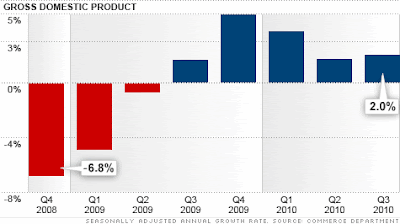The U.S.
The fear of double-dip recession in the U.S.
Gross domestic product (GDP), the broadest measure of the economy, grew at an annual rate of 2% in the three months ended in September 2010. While that's slightly better than 1.7% growth in the previous quarter, it is still considered too weak to create jobs.
"The U.S. economic recovery is still stuck in second gear," said Paul Ashworth, senior U.S.
The average growth rate during U.S.
Economists are not expecting significantly better growth any time soon. The forecast is for 2.5% growth in the fourth quarter, and 2.8% for all of 2011.
Besides, overall spending by households increased at a 2.6% pace, the best reading for that measure since the end of 2006. But disposable personal income was nearly flat in the quarter, which Ashworth said means consumers were dipping into savings.
Considering all, fears of the economy diving into double-dip recession have abated somewhat recently. Thursday, the Economic Cycle Research Institute, which published a widely-followed set of leading economic indicators, said it now believes the risk of a double dip has passed, although it does not forecast any pickup in growth in the foreseeable future.
And there were some bright spots in Friday's report, including strong spending by consumers on big-ticket durable goods, such as cars and appliances, as well as strong spending on services.
"That's good, because services are where the jobs are," said Robert Brusca of FAO Economics. "I think the economy is a half-full glass that is filling. If fears of a double-dip start to recede, that might make businesses more confident about hiring, which will feed growth even more."
The Federal Reserve is already widely expected to announce plans to pump hundreds of billions of dollars into the economy when it meets next week. And Friday's report supports the argument that the economy needs a push to get moving again.

Comments
Post a Comment